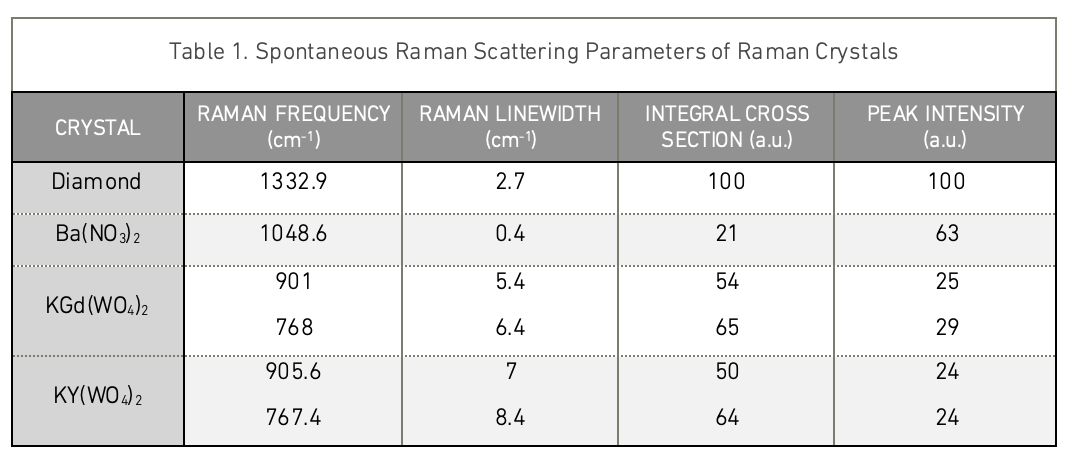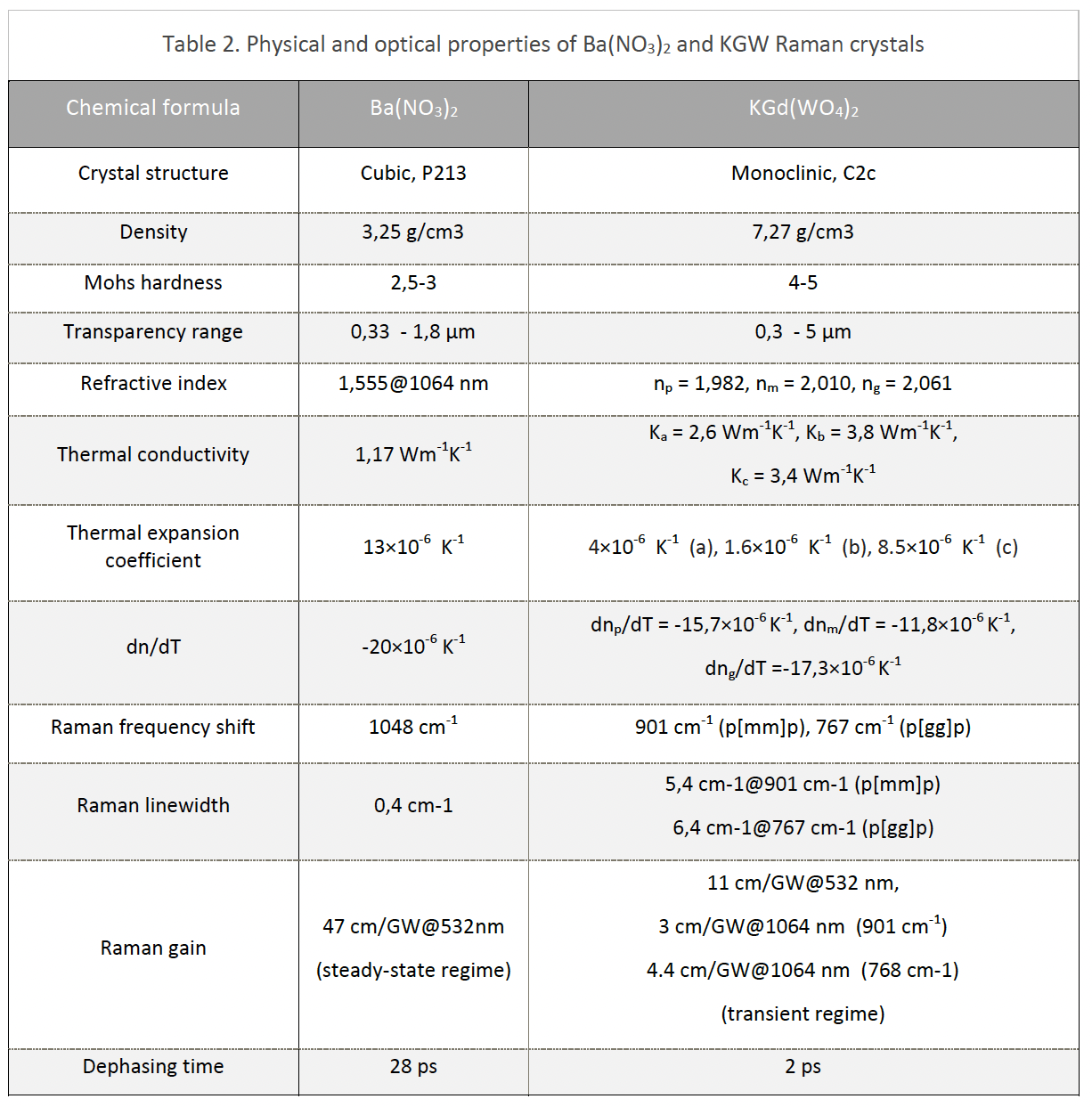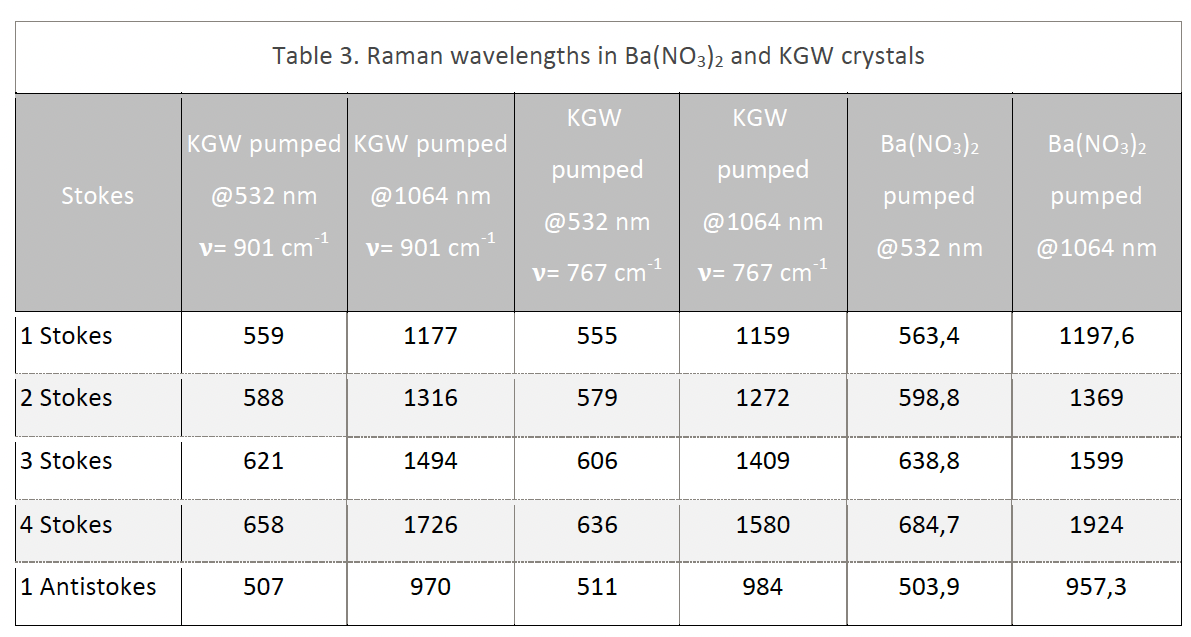2023-10-05
Raman Crystals
All solid-state sources of laser radiation in the spectral regions not covered by commercial lasers are highly desirable. This is due to the growing number of applications for these devices in medicine, spectroscopy, defence, and research. Stimulated Raman Scattering (SRS) allows the frequency of laser radiation to be shifted into these spectral regions. The use of solid-state Raman shifters is advantageous due to high conversion efficiency, no need for phase matching and easier handling compared to gaseous and liquid Raman cells. Among the most efficient commercial Raman active crystals are barium nitrate Ba(NO3)2 and potassium gadolinium tungstate KGd(WO4)2 (KGW). The diamond crystal, which exhibits a large Raman frequency shift and high gain, has not found commercial applications as a Raman material due to its small dimensions and high cost.
SRS temporal regimes and spontaneous Raman scattering parameters of Raman crystals
Two temporal cases of SRS can be considered, steady state and transient, depending on the duration of the pump laser pulse. The steady state case is observed when the duration of the pump laser pulse is longer than the vibronic relaxation time. In the steady state case, the Raman gain coefficient is linearly proportional to the Raman scattering cross section and inversely proportional to the Raman linewidth.
The Raman linewidth is determined by a mechanism of vibronic phase relaxation due to phonon-phonon coupling in the medium. The value of the Raman scattering cross section can be measured as a maximum in the spontaneous Raman scattering spectrum. In the transient case, the transient Raman gain depends on the integral Raman scattering cross section. In this case the Raman gain can be measured as the integral of the Raman line intensity in a spontaneous Raman scattering spectrum. The spontaneous Raman scattering parameters in diamond, barium nitrate, and rare earth tungstates have been measured in [1] and the results are summarized in Table 1.

Since the diamond has one of the most intense Raman lines, the values of the integral cross section and the peak intensity for the other crystals have been normalized to those of the diamond. As mentioned above, the integral Raman scattering cross section determines the Raman gain coefficient in the transient case. A comparison of this parameter in different materials shows high values in diamond and tungstate crystals (50-65% of that in diamond). A lower value is observed in barium nitrate crystal (21%). These data explain why the KGW crystal, with its Stokes shifts of 901 and 768 cm-1 and high resistance to moisture, is one of the most popular materials for picosecond SRS operation today. Similar properties are found in another tungstate crystal - potassium yttrium tungstate KY(WO4)2.
Since the steady-state Raman gain coefficient is defined by the peak cross section, it follows from Table 1 that high amplification is expected in diamond and barium nitrate crystals. Although the integral cross sections of the SRS active vibronic modes of Ba(NO3)2 are 2-3 times smaller than those of tungstates, this crystal has a high value of peak intensity due to the narrow Raman line. The peak cross section of the Raman mode in Ba(NO3)2 has a high value of 60% of that of diamond, which is more than twice that of tungstate crystals.
Comparison of the spontaneous Raman scattering spectra of crystals shows that barium nitrate crystals must have higher values of the Raman gain coefficient for steady-state SRS of nanosecond pulses. The shortening of the pump pulses below 20-100 ps leads to a transient behavior of the SRS in this crystal and to an increase of the SRS threshold. The use of tungstate crystals with comparatively large Raman linewidths and large integral cross-sections can be suggested for operation with picosecond pump pulses.
Physical, optical and SRS properties of Raman crystals
The physical and optical properties of Ba(NO3)2 and KGW Raman crystals are summarized in Table 2.

Barium nitrate Ba(NO3)2 is one of the leading crystals among solid-state Raman shifters in terms of Raman gain coefficient, which is highest in the nanosecond steady-state regime (47 cm/GW@532 nm pump). Barium nitrate has also a moderately broad transparency range (0.33 µm - 1.8 µm) and a high damage threshold. Disadvantages of Ba(NO3)2 crystals are low thermal conductivity (1.17 Wm-1K-1) and high thermo-optic coefficient (dn/dT= -20×10-6 K-1), leading to thermal lensing. The crystal is soft and hygroscopic and should be handled with care. Barium nitrate is a good Raman shifter for nanosecond applications.
The potassium gadolinium tungstate crystal KGd(WO4)2 (KGW) has good mechanical properties, relatively good thermal conductivity (2.5-3.4 Wm-1K-1) and a wide transparency range from 350 nm to 5 µm. As a Raman crystal, KGW has two large Raman modes at 768 cm-1 and 901 cm-1, which depend on the pump polarization. The KGW crystal has found many practical applications for frequency shifting, especially for picosecond laser pulses.
Raman wavelength observed in Ba(NO3)2 and KGW crystals are given in the Table 3.
Nd:KGW crystals for self-Raman lasers
It is also possible to use Nd-doped KGW crystals for self-Raman lasers. Self-Raman lasers (SRLs) are the lowest cost Raman lasers and allow simple and compact setups. In these lasers, the fundamental laser transition, and the stimulated Raman scattering (SRS) take place in the same crystal, so the number of optical components in the cavity is smaller than in cavities with separate crystals for fundamental and Stokes wavelength generation, thus reducing intracavity losses and providing higher efficiency.
Nd:KGW is an efficient laser medium due to its large emission cross section, broad absorption spectrum, high optical damage threshold, and capability of high Nd3+ doping concentration. The combination of the excellent lasing properties of the Nd3+ ion with the efficient Raman conversion in the KGW host makes Nd:KGW a very attractive material for Q-switched and mode-locked self-Raman lasers, including lasers emitting in the “eye-safe” spectral range for laser rangefinders. At the fundamental Nd:KGW laser wavelength of 1351 nm an efficient first Stokes Raman shift to a wavelength of 1538 nm has been achieved.
Order today
Optical elements of large size and good optical quality from Ba(NO3)2, KGd(WO4)2, KY(WO4)2 and Nd:KGd(WO4)2 are commercially available at moderate prices from 4Lasers.
Please do not hesitate to contact the team for support and services in any of the following areas:
- Manufacture of standard and custom laser optical components, lasers, and non-linear crystals;
- Design and development of custom optical modules, and beam delivery devices;
- Development and manufacture of various laser crystal hosts and ion dopant combinations;
- Conventional and state-of-the-art laser optics;
- Refurbishment of optical elements, crystals;
- Clean room environment, optical design, mechanical design, in-house CNC machining.
References
1.T.T. Basiev, A.A. Sobol, P.G. Zverev, V.V. Osiko, and R.C. Powel „Comparative spontaneous Raman spectroscopy of crystals for Raman lasers“ Applied Optics, 38, 594-598 (1999).
Contacts
E-mail: [email protected] Phone: +370 5 219 4884 Fax:+370 5 219 4883
